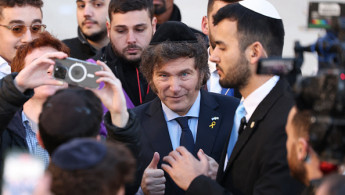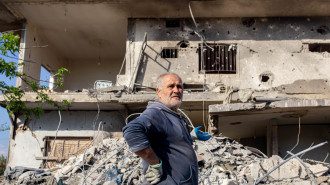Did Argentina's president call for Al-Aqsa's destruction and rebuilding of 'Third Temple'?
Argentina's new libertarian president Javier Milei has been accused of calling for the rebuilding of the 'Second Temple' in Jerusalem, a key demand of far-right Israeli extremists.
Milei visited Israel last week where he pledged to move the Argentine embassy from Tel Aviv to Jerusalem, despite Palestinians claiming the eastern sector as a capital for their future state, and pledged support for Israel's war on Gaza.
Later, Milei was accused by pro-Palestine campaigners of calling for the destruction of the Al-Aqsa Mosque and rebuilding the 'Third Temple' in its place.
While there is no proof he directly called for this, he did re-tell a messianic fable about the destruction of the holy site by the Romans and the response of a contemporary rabbi.
Who is President Milei?
Javier Milei is a right-wing libertarian politician, who has promised to enact year-zero policies to reconfigure the flailing Argentine economy.
He is also known to be a huge supporter of Israel, pledging to move his embassy from Tel Aviv — where most foreign embassies are based — to Jerusalem.
Milei, raised a Catholic, is rumoured to have converted to Judaism, having closely studied Jewish scripture and having a personal rabbi for years.
During his visit to Jerusalem, he prayed at the 'Western Wall' where he wept among a crowd of supporters.
What happened?
In a video shared online, Milei is seen telling a crowd in Jerusalem an apocalyptic biblical story about the Jewish sage Rabbi Aqiba or Akiva.
It recounts the rabbi's response to the destruction of the 'Second Temple' in Jerusalem by the Romans.
"This story took place after the destruction of the Second Temple by the Romans. Rabbi Aqiba and his colleagues were observing the Temple Mount in ruins and saw a fox leaving the Holiest of Holies in the temple," Milei said in Spanish.
"There could have been no more disheartening scene than that. In the face of this terrible scene, the rabbis cried in mourning but Rabbi Aqiba started to laugh.
President of Argentina, Javier Milei, calls for the rebuilding of the so-called Third Temple during his visit to Jerusalem. This process involves the destruction of the Al-Aqsa Mosque. pic.twitter.com/RxwTsbYfH8
— PALESTINE ONLINE 🇵🇸 (@OnlinePalEng) February 10, 2024
"His colleagues asked how he could possibly laugh in the face of such a tragedy, to which Rabbi Aqiba answered: 'There is a prophecy about the destruction that says a fox will break into the Holiest of Holies. There is another prophecy that says the same place will be rebuilt.'
"Now that I see with my own eyes the first prophecy come true, I laugh in joy and full of hope as the second prophecy will surely come true."
The clip was edited but did not appear to show any direct call for the destruction of the Al-Aqsa Mosque or the construction of the temple.
The New Arab has reached out to the Argentine embassy for clarification on the claims.
Why is this controversial?
Jewish fundamentalists believe that the Muslim Al-Aqsa Mosque, the third holiest site in Islam, is built on the ruins of the Second Temple, whose existence at the site is disputed by archaeologists.
Many Israelis have called for the destruction of the mosque and the construction of a new temple to replace it.
This would be an act of cultural genocide, and likely trigger further unrest in the region.
Jewish far-right activists regularly raid the mosque and carry out prayers and attempted sacrifices at the Al-Aqsa complex, despite Jewish religious rituals being banned at the site.
Jordan has frequently clashed with Israel about building work at Al-Aqsa and the mosque being disrespected by soldiers and far-right activists during raids.
Jordan has also forbidden archeological digs at the holy site, viewing it as a desecration.
Despite this, there have been calls by some Israelis for archaeological work at the Al-Aqsa compound to find the alleged foundations of the temple at the site, despite there being no firm evidence yet uncovered.





 Follow the Middle East's top stories in English at The New Arab on Google News
Follow the Middle East's top stories in English at The New Arab on Google News


![MP Essam Diab's pursuit to block TikTok in Egypt has revived an already ongoing debate in the country. [Getty]](/sites/default/files/styles/image_330x185/public/1230748046.jpeg?h=a5f2f23a&itok=-8MqBLLC)